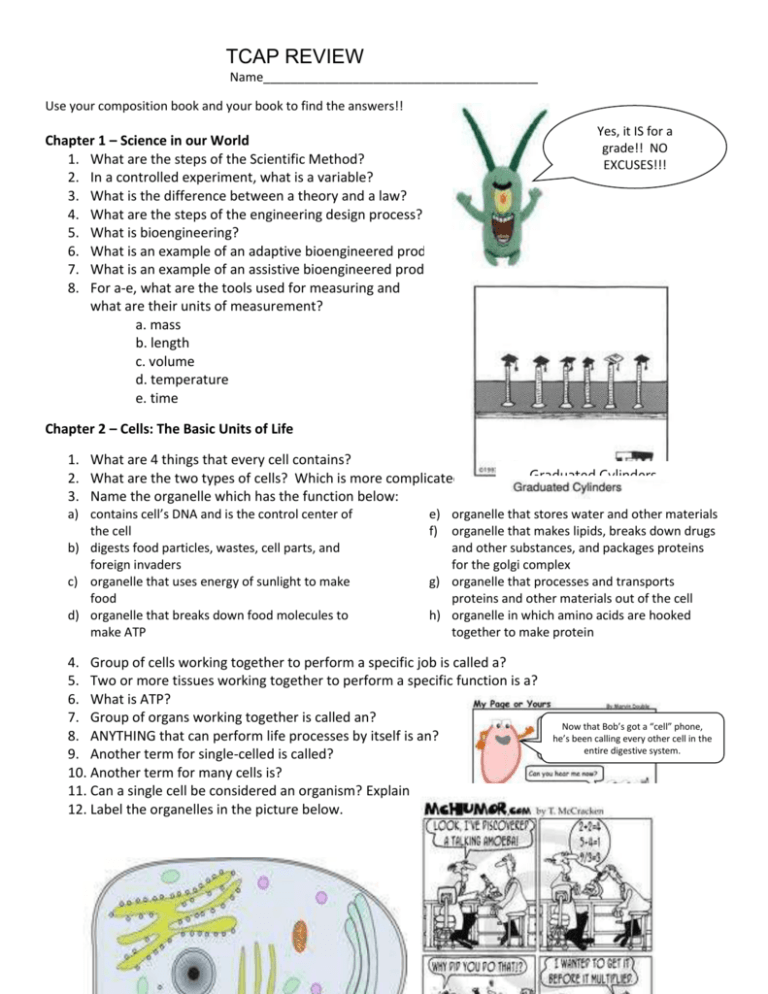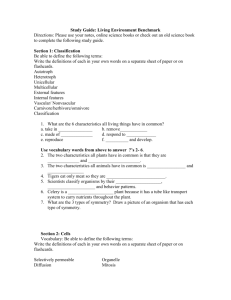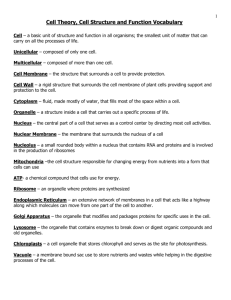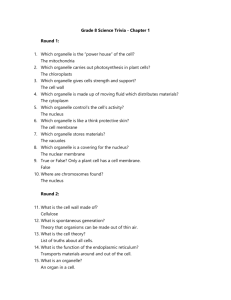TCAP REVIEW
advertisement

TCAP REVIEW Name________________________________________ Use your composition book and your book to find the answers!! Chapter 1 – Science in our World 1. What are the steps of the Scientific Method? 2. In a controlled experiment, what is a variable? 3. What is the difference between a theory and a law? 4. What are the steps of the engineering design process? 5. What is bioengineering? 6. What is an example of an adaptive bioengineered product? 7. What is an example of an assistive bioengineered product? 8. For a-e, what are the tools used for measuring and what are their units of measurement? a. mass b. length c. volume d. temperature e. time Yes, it IS for a grade!! NO EXCUSES!!! Chapter 2 – Cells: The Basic Units of Life 1. What are 4 things that every cell contains? Graduated Cylinders 2. What are the two types of cells? Which is more complicated? Give an example of each. 3. Name the organelle which has the function below: a) contains cell’s DNA and is the control center of the cell b) digests food particles, wastes, cell parts, and foreign invaders c) organelle that uses energy of sunlight to make food d) organelle that breaks down food molecules to make ATP e) organelle that stores water and other materials f) organelle that makes lipids, breaks down drugs and other substances, and packages proteins for the golgi complex g) organelle that processes and transports proteins and other materials out of the cell h) organelle in which amino acids are hooked together to make protein 4. Group of cells working together to perform a specific job is called a? 5. Two or more tissues working together to perform a specific function is a? 6. What is ATP? 7. Group of organs working together is called an? 8. ANYTHING that can perform life processes by itself is an? 9. Another term for single-celled is called? 10. Another term for many cells is? 11. Can a single cell be considered an organism? Explain!!! 12. Label the organelles in the picture below. Now that Bob’s got a “cell” phone, he’s been calling every other cell in the entire digestive system. Chapter 3 – The Cell in Action 1. 2. 3. 4. 5. What is diffusion? The diffusion of water across a semipermeable membrane is? What does semi permeable mean? What is the difference between active and passive transport? What is the difference between endocytosis and exocytosis? Are they types of active or passive transport? 6. What is the formula for photosynthesis? 7. What is the purpose of photosynthesis? 8. In which organelle does photosynthesis occur? 9. What is the formula for cellular respiration? 10. What is the purpose of cellular respiration? 11. In which organelle does cellular respiration occur? 12. How are photosynthesis and cellular respiration connected? 13. What is a chromosome? 14. What are the steps of the cell cycle? 15. What are the steps of mitosis? 16. How many new cells are produced from the process of mitosis? 17. What is cytokinesis? 18. Label the steps of mitosis and put them in order… Dude, mitosis starts in five minutes… I can’t believe you’re not condensed yet. Chapter 4 – Heredity 1. 2. 3. 4. 5. What is a dominant trait? What is a recessive trait? What is the difference in the F1 and F2 generations? What is a gene? What are alleles? 6. What is the difference between genotype and phenotype? 7. Draw a punnett square crossing a Homozygous Dominant Yellow SpongeBob and a homozygous recessive blue Spongegal. a. What are the genotypes of the parents? b. What are the genotypes of the offspring? c. What are the phenotypes of the offspring? 8. What is the purpose of meiosis? 9. In Meiosis, how many NEW cells are produced from the original cell? How many chromosomes do the NEW cells have as compared to the original parent cell? 10. What are the Sex chromosomes? 11. What is a pedigree? Answer question #8 on page 119 Chapter 6 – Plants 1. 2. 3. 4. 5. 6. 7. 8. What is chlorophyll used for in a plant? What is the function of a cell wall? For sexual reproduction in plants, where does the sperm form in seed plants? What are angiosperms? What is the female reproductive part of a flower called? Male? What are the parts of the female reproductive part of a flower? What are the parts of the male reproductive part of a flower? Label the parts of the flower below… Mutant Jeans 9. Describe the process of SEXUAL reproduction (aka…pollination and fertilization) in flowering plants (pages 189-190). 10. What are some ASEXUAL methods of reproduction in flowering plants (pages 190-191)? Draw and describe. 11. What are some ASEXUAL methods of reproduction in animals? (Page 310)? Chapter 8 – Body Organization and Structure 1. Which organ system contains the heart and is used to pump blood through all of the vessels? 2. Which organ system produces eggs and nourishes and protects the growing baby? a) b) c) d) e) f) g) h) i) j) k) 3. Which system has glands that send out chemical messages? 4. In which organ system(s) do the ovaries and testes belong? 5. Which organ system contains skin hair and nails? 6. Which system works WITH the skeletal system to move the body? 7. Which system removes wastes from the blood and regulates the body’s fluids? 8. Which system absorbs oxygen and releases carbon dioxide? 9. Which system provides a frame to support and protect the body parts? “Still, let’s do an X-ray just to be sure…” 10. Which system receives and sends electrical messages throughout the body? 11. Which system breaks down the food you eat into nutrients that the body can absorb? 12. Which system returns leaked fluid back to the blood vessels and also helps get rid of bacteria and viruses? 13. For the organs listed below, name the organ system to which they belong. hair l) stomach s) sternocleidomastoid (I love bicep m) lymph nodes, spleen, and that one, too!) skull thymus t) arteries and veins lungs n) pituitary, thyroid, and u) spinal cord patella (knee cap) adrenal glands v) bladder, urethra, and aorta o) liver ureters trachea p) rectus abdominus w) Tongue (awww…have to uterus q) fingernails think on this one!!) blood r) Phalanges (I love that x) esophagus kidney word!) y) large and small intestines brain 14. How many chromosomes do humans have? (page 311) 15. The process of meiosis produces sex cells…the sex cells of males are called _______________ and the sex cells of females are called _________________. (page 311) 16. Put these words in order from smallest to largest…and if you don’t know what they mean…WRITE DOWN THEIR DEFINITION!!! *Organism *Organ system * Tissue *Chromosome *Gene *DNA *Nucleus * Cell *Organ Chapter 13 – Minerals of the Earth’s Crust 1. What are the 4 characteristics of a mineral? 2. Silicate minerals contain a combination of the elements __________________&_________________. 3. Name at least 7 ways to identify different minerals. 4. What does the Mohs scale measure? 5. What is the hardest known mineral? 6. A mineral with a hardness of 5 (will, will not) be scratched by a mineral with a hardness of 3. 7. What are some special properties of minerals? 8. What is the difference between surface and subsurface mining? 9. What does reclamation mean? 10. What is an ore? 11. How can mining cause water pollution? Chapter 14 – Rocks: Mineral Mixture 1. Fill in the missing parts of the rock cycle below. 2. 3. 4. 5. 6. 7. What is the most noticeable feature of sedimentary rocks? What is the difference between intrusive and extrusive igneous rocks? What would the texture of an igneous rock that cooled very quickly look like? What are 3 types of sedimentary rock? Metamorphic rock textures are sometimes “foliated”…What does this mean? What is the difference between weathering and erosion? Chapter 15 – Plate Tectonics 1. Label the parts of the Earth. _______ 2. The outermost rigid layer of the Earth is? 3. The plastic layer of the mantle on which pieces of the lithosphere move is the? 4. The strong lower part of the mantle is the? 5. Which part of the core is solid? 6. Which part of the core is liquid? 7. Which is thicker: oceanic or continental crust? 8. What is the thinnest layer of the Earth? 9. Which layer of the Earth contains the most mass? 10. Which layer of the Earth is made mostly of iron? 11. The picture below on the left shows pieces of the earth’s lithosphere that move around on top of the asthenosphere. What are these pieces called? #11 “Well, looking back, I suppose it’s been going on for 12. What is continental drift? quite some time, but I only noticed we were drifting 13. What is Pangaea? apart during the last 50 million years….” 14. What are the types of boundaries seen below? 15. The speed a tectonic plate moves per year is best measured in a. kilometers, b. meters, c. centimeters, or d. millimeters 16. The San Andreas Fault in California is an example of what type of boundary? What is the result when this area moves? 17. When tectonic plates collide, what is often formed? 18. What can be formed at divergent boundaries? 19. Which layer of the earth has convection currents that may be the reason for tectonic plate movement? 20. What type of fault is seen below…normal, reverse, or strike-slip? Chapter 18 – Energy Resources 1. What is the difference between a renewable and nonrenewable resource? 2. What are some examples of each? 3. What is the liquid fossil fuel? What types of products are made from it? 4. What is the gaseous fossil fuel? Products? 5. What is the solid fossil fuel? What are some uses of this fuel/ 6. What type of rock is coal (this would refer to question #5 from the section of chapter 14) 7. What are some problems with fossil fuels? 8. What is the difference between nuclear fission and nuclear fusion? 9. What are some pros and cons (good and bad) of nuclear energy? (Japan, for example) 10. Name some alternative energy sources. 11. What is biomass? Chapter 19 – Matter in Motion 1. 2. 3. 4. 5. 6. 7. How is speed determined? What is the difference between speed and velocity? Any push or pull is a? Force is found how? Force is measured in? Unbalanced forces produce a change in __________________________. Determine the net force on the boxes pictured below. 8. Friction depends on what 2 things? 9. How is friction good? 10. How is friction bad? 11. What is the difference between weight and mass? Chapter 20 - Forces and Motion 1. 2. 3. 4. 5. 6. 7. What is terminal velocity? What is free fall? What is projectile motion? What are Newton’s 3 laws of motion? Give an example of each. What is momentum? How is momentum calculated? What is the law of Conservation of momentum? Chapter 21 – Work and Machines 1. What is work and how is it calculated? 2. What is the unit of measurement for work? 3. What is power and how is it calculated? 4. What is the unit of measurement for power? 5. What is a machine? 6. What is work output? 7. What is work input? 8. What is the difference between a simple machine and a compound machine? 9. What are 6 types of simple machines? 10. For each of the pictures below, tell what type of simple machine it is. a) e) c) b) 11. What is a block and tackle? 12. What is a compound machine? d) f) Chapter 22 – The Energy of Waves 1. In a ___________________________ wave, the particles vibrate parallel to the direction that the wave travels. 2. In a ___________________________ wave, the particles vibrate perpendicular to the direction the wave travels. 3. ______________________ waves require a medium through which to travel. (page 603) 4. What is a medium? (page 603) 5. What are some examples of mechanical waves? 6. Which waves can travel without going through a medium? 7. Waves transfer a. matter b. energy c. particles d. water 8. Label the wave below with the following terms: Crest trough amplitude wavelength 9. _________________________ can be measured by counting how many waves pass by in a certain amount of time. 10. How is wave speed calculated? 11. What is the unit of measurement for frequency of a wave? 12. What is reflection? 13. What is refraction? 14. What is diffraction? 15. What is interference? “IS HE STILL THERE FRANK?”










